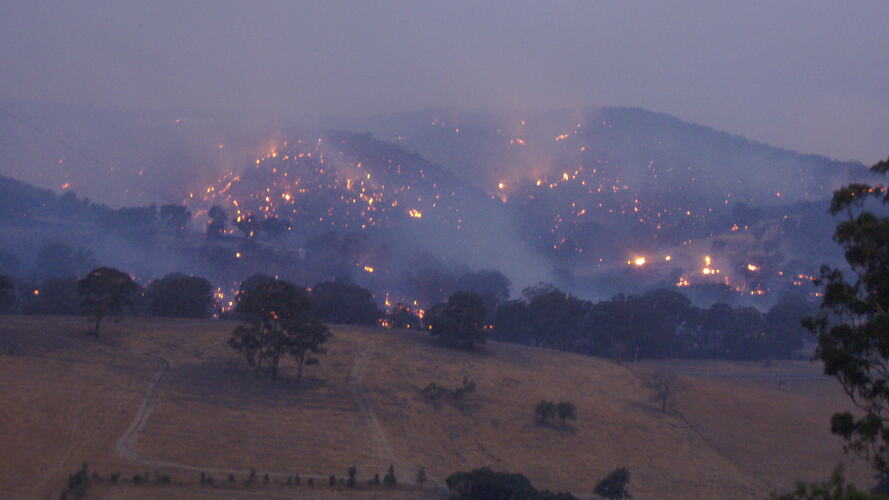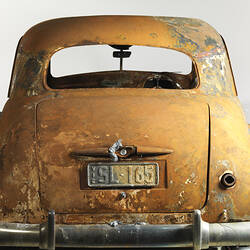Summary
Maurice Squirrell, local resident and farmer, took this photograph from his property at Ridge Road, Whittlesea at 7.39pm on 15 February, 2009, one week after the Black Saturday Bushfires. The photograph shows the western face of the Sherwin Ranges is alight - part of a back burning operation undertaken by the Department of Sustainability and Environment.
Maurice offered this photograph for inclusion in the community-led Bushfire Photo Exhibition, which featured thirty-five local photographs, at the Bridges Restaurant/Nursery, Hurstbridge, held between February and March 2010. It was also published in the book 'Footsteps in the Ash' which documents St Andrews' and Strathewen's experiences during Black Saturday. This image is part of the the Victorian Bushfire Collection.
Description of Content
This digital colour photograph was taken approximately one week after Black Saturday by Maurice while facing east from his property at Whittlesea. The image shows the western face of the Sherwin Ranges alight with hundreds of spot fires as part of a controlled back burning operation. Yellow Box and Stringy Bark trees are identifiable in the image. The tracks showing in the midground of the image were the result of fire trucks accessing Maurice's dams for re-filling. Maurice took this and other images from his deck during a BBQ with friends and family at approximately 9.00pm, documenting what Maurice believes to be the last attempt of an urgent, three day government back burn operation that included his property. 'It shows part of the subsequent action presumably taken to burn a significant strip of forest to give a barrier between the main fire area of Coombs Road to Strathewen, and the Yan Yean Reservoir Reserve which would provide assistance in fighting a return of the fire under the conditions of temperature and wind direction that prevailed on the 9 February2009 ... Should a fire have become established under the prevailing weather conditions of that time on the 9th, the fire may well have entered the north-eastern fringe of the built metropolitan area of Melbourne at Laurimar and kept travelling'. [interview, Maurice Squirrell, 13 May 2011] Maurice took this photograph because it was a spectacular event and it was happening on his property. During the operation CFA fire vehicles used Maurice's large dam to refill their tanks with water from a temporary pumping point, which ultimately resulted in the successful control of the fire, minimising the risk to Maurice's house, himself and his family. He commented that the event was 'a hurried, heavily resourced, large-strip back burn (in terrain that was largely inaccessible). On this night there appeared to be a systematic pattern of dropping fire bomb-lets from helicopters'. [interview, Maurice Squirrell, 13 May 2011]
Physical Description
Digital photograph.
Significance
The bushfires of Black Saturday, 7 February 2009, caused significant loss of life and damage to personal and community property, and state infrastructure - and became the worst bushfire disaster in Australia's history. The Kilmore East fire swept over Mount Sugarloaf on Black Saturday destroying most of the small settlement of Strathewen and causing the largest loss of life of any community in Victoria. Despite the high death toll and widespread devastation, an astonishing number of creative projects have arisen to give comfort and help in the recovery efforts. This photograph is one of many that were used in a local photographic display and a publication which documented the many stories of loss and survival.
The photograph documents the attempts made to reduce the the threat of fire spreading to metropolitan Melbourne through controlled burning in the days following Black Saturday. Revealing the highly contentious issue of back burning within the communities it effects, the photograph represents how the effects of back burning operations impact on property owners with access to facilities useful for firefighting.The image also demonstrates a local resident's personal experience, including threats to personal safety, and, confronting challenges in deciding what to do next when operating under stressful situations.
It is also and important and rare document of the photographer's personal experience as a local resident during Black Saturday.
More Information
-
Collection Names
-
Collecting Areas
Sustainable Futures, Home & Community, Images & Image Making, Information & Communication
-
Acquisition Information
Donation from Mr Maurice Squirrell
-
Place & Date Depicted
Whittlesea, Greater Melbourne, Victoria, Australia, 14 Feb 2009
-
Photographer
Mr Maurice Squirrell, Whittlesea, Greater Melbourne, Victoria, Australia, 14 Feb 2009
-
Place & Date Exhibited
Bridges Restaurant, 1075 Heidelberg - Kinglake Road, Hurstbridge, Greater Melbourne, Victoria, Australia, Feb 2010
As part of the Of 'Bushfire Photo Exhibition'. The exhibition catalogue included photograph name, photographer and details of sale price. -
Organiser of Event
Ms Anita Norris, Arthurs Creek, Greater Melbourne, Victoria, Australia, Feb 2010
Of 'Bushfire Photo Exhibition' -
Author
Mr Jim Usher, St Andrews, Greater Melbourne, Victoria, Australia, 06 Feb 2010
Photograph published in 'Footsteps in the ash: the story of St Andrews and Strathewen in the 2009 bushfires' by Jim Usher and Mac Gudgeon. St Andrews, Vic. 2010. -
Format
Digital file, Colour
-
Classification
-
Category
-
Discipline
-
Type of item
-
Keywords
Backburning, Black Saturday Bushfires, 2009, Communities, Fire Fighting Equipment, Firefighting, Fires, Natural Disasters, Natural Environment, Photographers, Photographic Exhibitions, Photography, Rural Landscapes, Rural Life, Rural Victoria

